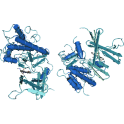
- Remove this product from my favorite's list.
- Add this product to my list of favorites.
Products
Viewed products
Newsletter
 |  |  |  |  |  |

Background: Extracellular signal-regulated kinase (ERK) is a serine/threonine protein kinase that functions as the major effector of the Ras protein, a small GTPase. The so called “ERK cascade” consists of three enzymes, the initial GTPase-regulated kinase Raf, (MAP3K) that phosphorylates and activates an intermediate kinase MEK (MAP2K) that, in turn, phosphorylates a threonine and a tyrosine residue of the activation loop of the effector kinase ERK (MAPK). Both, ERK1 and ERK2 share a high sequence identity (90%) and are co-expressed in most tissues but differ in their relative abundance. The substrate specificities of the ERK1 and ERK2 protein kinases are very similar. The consensus sequence for ERK1 substrates has been identified as -Pro- Leu-Ser/Thr-Pro. Both kinases are involved in proliferation, differentiation, cell cycle processes, and survival. ERK1 / 2 differentially phosphorylates a variety of nuclear (Elk-1, c-Myc), cytosolic (MNK1/2, Raf) and cytoskeletal (MAP2, Tau) targets. Since the ERK pathway is often up-regulated in human tumors it represents an attractive target for anticancer drugs development.
Human ERK1, recombinantly expressed in E. coli. Unactive form not phosphorylated by MEK1.
Molecular weight based on amino acid sequence 43.6 kDa.
Purity > 95% (SDS PAGE).
Specific activity < 200 Units/mg.
No protease activity detectable.
Entrez Gene ID: 5595
UniProtKB: P27361
Ordering information: shipped on dry ice
Gonzalez FA, Raden DL, Davis RJ (1991) "Identification of substrate recognition determinants for human ERK1 and ERK2 protein kinases" J. Biol. Chem. 266(33):22159-63
Meloche S, Pages G, Pouyssegur J (1992) "Functional expression and growth factor activation of an epitope-tagged p44 mitogen-activated protein kinase, p44mapk" Mol Biol Cell 3(1):63-71
Hartsough MT, Mulder KM (1995) "Transforming growth factor beta activation of p44mapk in proliferating cultures of epithelial cells" J Biol Chem. 270(13):7117-24
Songyang Z, Lu KP, Cantley LC et al. (1996) "A structural basis for substrate specificities of protein Ser/Thr kinases: primary sequence preference of casein kinases I and II, NIMA, phosphorylase kinase, calmodulin-dependent kinase II, CDK5, and Erk1" Mol Cell Biol. 16(11):6486-93
Wortzel I, Seger R. (2011) “The ERK Cascade: Distinct Functions within Various Subcellular Organelles.” Genes Cancer. 2(3):195-209.
Kohno M, Pouyssegur J(2006).” Targeting the ERK signaling pathway in cancer therapy”. Ann Med.;38(3):200-11.
Mazzucchelli C, Vantaggiato C, Brambilla R et al. (2002) "Knockout of ERK1 MAP kinase enhances synaptic plasticity in the striatum and facilitates striatal-mediated learning and memory" Neuron 34(5):807-20
Follow us